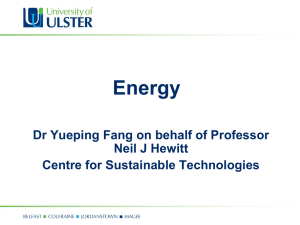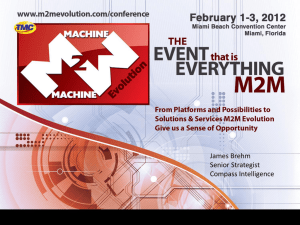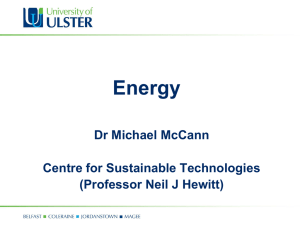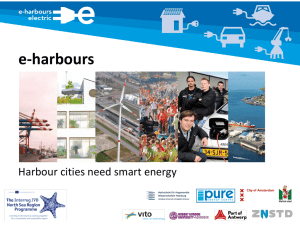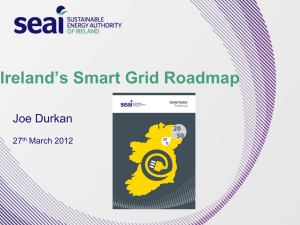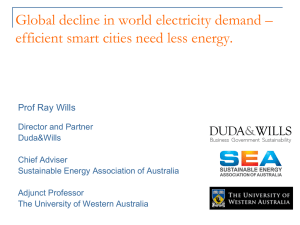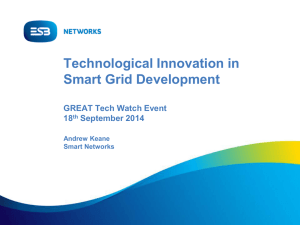Smart grids - World Trade Institute
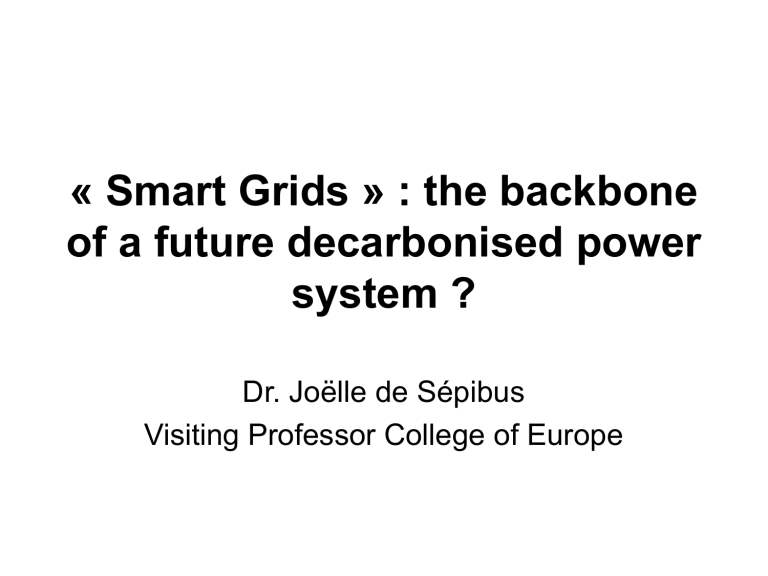
« Smart Grids » : the backbone of a future decarbonised power system ?
Dr. Joëlle de Sépibus
Visiting Professor College of Europe
Outline
• From monopoly to competition in the
European electricity markets:
• The climate challenge:
– The decarbonisation of power production
• The deployment of « Smart Grids »: the backbone of a future decarbonised power system ?
The ‘traditional’ monopoly structure of the electricity industry
• Alternative current is at the root of the current structure of the power industry:
– A system which generates electricity in large power stations at remote sites and carries it over long networks to distant users
• Management by a vertically integrated company:
– Power generation
– Transmission (high voltage networks)
– Distribution
– Supply of electricity (billing, metering)
Progressive Liberalisation of the
European Electricity Market
• Shortcomings of the monopoly system:
– Large scale investment and lack of competition
– Those who planned, managed, and operated the system did not carry any of the risk and did not suffer if they erred
– Difficult introduction of small-scale electricity production
• Response of the European Union:
– Progressive introduction of competition for generation and supply of electricity under the influence of the neo-liberal ideology
The Legislative Electricity
Framework of the EU
• The first legislative initiative
– The ‘first’ Electricity Directive (1996)
• The second legislative package
– The ‘second’ Electricity Directive (2003)
– The Cross-Border Regulation (2003)
– The Security of Supply Directive (2005)
• The third legislative package
– The ‘third’ Electricity Directive (2009)
– The Second Cross-Border Regulation (2009)
– The Regulation establishing an Agency for the
Cooperation of Energy Regulators (ACER) (2009)
Liberalising the European
Electricity Markets
• Main principles:
– Competition in the generation and supply of electricity and freedom of choice for customers
– The networks remain a monopoly
– Non-discriminatory third party access (TPA) to networks
– Unbundling’ rules for vertically integrated companies
(accounting, legal, ownership unbundling)
– Designation of national energy regulators
– Creation of an Agency for the Cooperation of
Energy Regulators
The EU „climate and energy package“ - 2007
• New commitments by the EU for 2020 :
– Pledge to reduce the EU GHG by 20% (1990)
– Increase the share of renewable energy (20%)
– Increase of energy efficiency by 20%
• Legislative framework:
– Package of measures (2009)
• Amendment of the Emission Trading Scheme (2013-2020)
• New Directive for Renewable Energies
• The Directive on Carbon Capture and Storage (CCS)
• Strategic Energy Technology Plan (the ‘SET-Plan’)
Climate related challenges for the liberalised electricity markets
• Reduction of CO
2 emissions
– Low carbon generation of electricity (switch from coal to gas, equipment of fossil fuel power stations with CCS)
– Increase of renewable energy sources (RES)
• Small-scale production (solar, onshore wind, geothermal, biomass) – „distributed generation“
• Large offshore wind production
– Increase of energy efficiency
The effects of liberalisation for a decarbonised power sector
• For a thorough appraisal see, in particular:
Joëlle de Sépibus ,
The Liberalisation of the Power Industry in the
European Union and its Impact on Climate
Change
A Legal Analysis of the Internal Market in
Electricity , WTI Working Paper No 2008/10
Network-related barriers for RES
• ‘Traditional’ networks:
– Largely « passive » management of networks (coal, nuclear, gas)
• Principal barriers for the introduction of small-scale RES
– Despite « unbundling » and regulated TPA still bias againt small distributed generation (highly concentrated market)
– ‘Unfair’ network tariffs (high connection charges)
– Insufficient « intelligence » of aging networks
• Principal barriers for the introduction of large-scale RES, especially wind offshore
– Insufficient transmission capacities and interconnection capacity between Member States
The Response of the EU….the
Deployment of « Smart Grids »
Smart Grids:
“ upgraded electricity networks to which two-way digital communication between supplier and consumer, intelligent metering and monitoring systems have been added
“
What is a Smart Grid ?
Like blinded men with an elephant
Smart Grid
•
Modernised electricity delivery system which monitors, protects and automatically optimizes the operation of its interconnected elements
•
The Smart Grid sits at the intersection of Energy, IT and Telecommunication
Technologies
• .
Smart Grid – „when power meets intelligence“
Smart
Generation
Smart
Distribution and
Transmission
Communication between system components
Smart
Consumption
Smart
Storage
Interdisciplinary technologies:
Data collection, processing and recombination
Market Grid Operation
Principal goals of the
„Smart Grid“
• to integrate national networks into a marketbased, truly pan-European network
• to guarantee a high-quality of electricity supply to all customers and to engage them as active participants in energy efficiency
• to anticipate new developments such as the electrification of transport
• to substantially reduce capital and operational expenditure for the operation of the networks, while maintaining the security of the system
Principal goals of the
„Smart Grid“
• Backbone of the future decarbonised power system:
– to transmit and distribute up to 35% of electricity from renewable sources by 2020 and a completely decarbonized electricity production by 2050, in particular through the integration of vast amounts of both on-shore and off-shore renewable energy
– Strong incentives for efficient energy use, combined in particular with time-dependent electricity prices
(„peak-shaving“)
Roadmap for a competitive lowcarbon economy in 2050
• Communication from the Commission
(2011) 112:
– “Smart Grids are a key enabler for a future low-carbon electricity system, facilitating demand-side efficiency, increasing the shares of renewables and distributed generation, and enabling electrification of transport”
EU legal framework for „Smart
Grids“
• Electricity Directive (2009/72/EC):
– Obliges Member States to define an implementaiton plan for the roll-out of intelligent metering systems
• Energy End-Use Efficiency and Energy Services
Directive (2006/32/EC):
– Regulatory incentives should encourage that a network operator to earn revenues that are not linked to additional sales, but based on efficiency gains
• European Council (2011):
– Invitation of MS to liaise with European standardisation bodies ‘to accelerate work with a view to adopting technical standards for electric vehicle charging systems and for smart grids and meters‘
EU support for the deployment of
„Smart grids“
• Technology push
– RTD&D projects since 2003, more than €300
Million EU support
– European Smartgrid Technology Platform
(launched 2006) ( www.smartgrids.eu
)
– European Energy Infrastructure Package, 2010 and
2011: http://ec.europa.eu/energy/infrastructure/index_en.ht
m
– SET- Plan – European Electricity Grid
Initiative (launched 2010
( https://www.entsoe.eu/rd/eegi/ )
EU support for the deployment of
„Smart grids“
• Coordination activities:
– Task Force for Smart Grids, launched in 2009
• Invitation by the Commission of all relevant institutional actors and market stakeholders „t o make regulatiory recommendations to ensure EU-wide consistent, costeffective, efficient and fair implementation of Smart Grids http://ec.europa.eu/energy/gas_electricity/smartgrids/taskforc e_en.htm
– Communication of the European Commission on
Smart Grids, COM(2011)202 - 12 April 2011
Communication of the European
Commission on Smart Grids
• Identified challenges:
– Consumer engagement at all levels
– Protection, handling and security of data
– Standardisation and interoperability
– Regulatory framework and incentives for infrastructure investments and roll out
Communication of the European
Commission on Smart Grids
• Standardisation and interoperability :
– Diverse mandates for standardisation given to
CEN, CENELEC and ESO by the Commission in 2010
• Regulatory framework and incentives
– If evaluation of the Energy Services Directive shows that progress is insufficient, the
Commission will consider the establishment of a Network Code on Tariffs
The road to a Smart Grid is still long and its success uncertain…..
Dr. Joëlle de Sépibus
Joelle.desepibus@wti.org
